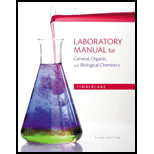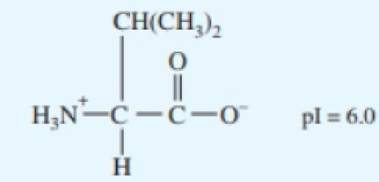
EBK LABORATORY MANUAL FOR GENERAL, ORGA
3rd Edition
ISBN: 9780321918352
Author: Timberlake
Publisher: YUZU
expand_more
expand_more
format_list_bulleted
Concept explainers
Textbook Question
Chapter 9, Problem 9.55PP
Valine has the zwitterion structure shown in the following figure. What form of valine will predominate at the indicated pH values?
- a. pH 1.0
- b. pH 6.0
- c. pH 11.0

Expert Solution & Answer
Want to see the full answer?
Check out a sample textbook solution
Students have asked these similar questions
(EXM 2, PRBLM 3) Here is this problem, can you explain it to me and show how its done. Thank you I need to see the work for like prbl solving.
can someone draw out the reaction mechanism for this reaction showing all bonds, intermediates and side products
Comment on the general features of the 1H-NMR spectrum of isoamyl ester provided below
What would be the best choices for the missing reagents 1 and 3 in this synthesis?
1. PPh3
3
2. n-BuLi
• Draw the missing reagents in the drawing area below. You can draw them in any arrangement you like.
• Do not draw the missing reagent 2. If you draw 1 correctly, we'll know what it is.
• Note: if one of your reagents needs to contain a halogen, use bromine.
Click and drag to start drawing a structure.
Chapter 9 Solutions
EBK LABORATORY MANUAL FOR GENERAL, ORGA
Ch. 9 - Prob. 9.1PPCh. 9 - Indicate if each of the following statements is...Ch. 9 - Prob. 9.3PPCh. 9 - Prob. 9.4PPCh. 9 - Prob. 9.5PPCh. 9 - In each of the following equations, identify the...Ch. 9 - Prob. 9.7PPCh. 9 - Prob. 9.8PPCh. 9 - Prob. 9.9PPCh. 9 - Which of the following are strong bases? a....
Ch. 9 - Prob. 9.11PPCh. 9 - Prob. 9.12PPCh. 9 - Prob. 9.13PPCh. 9 - Prob. 9.14PPCh. 9 - Complete and balance the following neutralization...Ch. 9 - Complete and balance the following neutralization...Ch. 9 - Prob. 9.17PPCh. 9 - Complete and balance the following neutralization...Ch. 9 - Prob. 9.19PPCh. 9 - Prob. 9.20PPCh. 9 - Write an equilibrium constant expression lor the...Ch. 9 - Prob. 9.22PPCh. 9 - Prob. 9.23PPCh. 9 - Prob. 9.24PPCh. 9 - Prob. 9.25PPCh. 9 - Sulfur trioxide is produced by reacting sulfur...Ch. 9 - Prob. 9.27PPCh. 9 - Prob. 9.28PPCh. 9 - Prob. 9.29PPCh. 9 - When you exercise, energy is produced by...Ch. 9 - Using Tables 9.1 and 9.6, identity the stronger...Ch. 9 - Using Tables 9.1 and 9.6, identify the stronger...Ch. 9 - Prob. 9.33PPCh. 9 - Identify the acid and base on the reactant side of...Ch. 9 - Prob. 9.35PPCh. 9 - Prob. 9.36PPCh. 9 - Prob. 9.37PPCh. 9 - Write the formula and name of the conjugate acid...Ch. 9 - Complete the following reactions and identify the...Ch. 9 - Complete the following reactions and identify the...Ch. 9 - State if each of the following solutions is...Ch. 9 - State if each of the following solutions is...Ch. 9 - State if each of these following solutions is...Ch. 9 - Slate if each of the following solutions is...Ch. 9 - Calculate the pH of each of the solutions in...Ch. 9 - Calculate the pH of each of the solutions in...Ch. 9 - Calculate the [H3O+] for each of the following...Ch. 9 - Calculate the [H3O+J lor each of the following...Ch. 9 - Prob. 9.49PPCh. 9 - Using Table 9.8, determine the stronger acid from...Ch. 9 - Prob. 9.51PPCh. 9 - Prob. 9.52PPCh. 9 - Prob. 9.53PPCh. 9 - Prob. 9.54PPCh. 9 - Valine has the zwitterion structure shown in the...Ch. 9 - Glycine has the zwitterion structure shown in the...Ch. 9 - Prob. 9.57PPCh. 9 - Prob. 9.58PPCh. 9 - During stress or trauma, a person can start to...Ch. 9 - A person who overdoses on antacids may neutralize...Ch. 9 - Prob. 9.61APCh. 9 - Prob. 9.62APCh. 9 - Prob. 9.63APCh. 9 - What are some ingredients found in antacids? What...Ch. 9 - Prob. 9.65APCh. 9 - Prob. 9.66APCh. 9 - Prob. 9.67APCh. 9 - Prob. 9.68APCh. 9 - For the following reaction, 2HI(g)H2(g)+I2(g) a....Ch. 9 - Prob. 9.70APCh. 9 - Prob. 9.71APCh. 9 - Prob. 9.72APCh. 9 - Prob. 9.73APCh. 9 - Prob. 9.74APCh. 9 - Prob. 9.75APCh. 9 - Prob. 9.76APCh. 9 - Determine the pH for the following solutions....Ch. 9 - Determine the pi! for the following solutions....Ch. 9 - Prob. 9.79APCh. 9 - Prob. 9.80APCh. 9 - Consider the acetic-acid buffer system with acetic...Ch. 9 - Consider the lactic-acid buffer with lactic acid,...Ch. 9 - In blood plasma, pH is maintained by the carbonic...Ch. 9 - Adding a few drops o! a strong add to water will...Ch. 9 - Consider the amino acid valine shown in its...Ch. 9 - Prob. 9.86CPCh. 9 - Prob. 9.87CPCh. 9 - Prob. 9.88CPCh. 9 - Prob. 9.89CPCh. 9 - Naproxen, the active ingredient in Aleve has the...Ch. 9 - To determine the concentration of an unknown weak...Ch. 9 - Explain why the following amino acid cannot exist...Ch. 9 - Prob. 1IA.1QCh. 9 - Prob. 1IA.2QCh. 9 - Prob. 1IA.3QCh. 9 - Prob. 1IA.4QCh. 9 - Prob. 1IA.5QCh. 9 - Provide the a. conjugate base of H2S. _______ b....Ch. 9 - If the lungs fail to expel normal amounts of CO2...Ch. 9 - If the lungs expel CO2 faster than normally...Ch. 9 - Prob. 2IA.3QCh. 9 - Prob. 2IA.4QCh. 9 - Prob. 1ICCh. 9 - Prob. 2ICCh. 9 - Prob. 3IC
Knowledge Booster
Learn more about
Need a deep-dive on the concept behind this application? Look no further. Learn more about this topic, chemistry and related others by exploring similar questions and additional content below.Similar questions
- Identify the missing organic reactants in the following reaction: X + Y H+ two steps Note: This chemical equation only focuses on the important organic molecules in the reaction. Additional inorganic or small-molecule reactants or products (like H2O) are not shown. In the drawing area below, draw the skeletal ("line") structures of the missing organic reactants X and Y. You may draw the structures in any arrangement that you like, so long as they aren't touching. Click and drag to start drawing a structure. Х :arrow_forwardDraw the mechanism of friedel-crafts acylation using acetyl chloride of m-Xylenearrow_forwardI need help naming these in IUPACarrow_forward
- H R Part: 1/2 :CI: is a/an electrophile Part 2 of 2 Draw the skeletal structure of the product(s) for the Lewis acid-base reaction. Include lone pairs and formal charges (if applicable) on the structures. 4-7: H ö- H Skip Part Check X :C1: $ % L Fi Click and drag to start drawing a structure. MacBook Pro & ㅁ x G 0: P Add or increase positive formal cha Save For Later Submit ©2025 McGraw Hill LLC. All Rights Reserved. Terms of Use | Privacy Centearrow_forwardDraw the friedel-crafts acylation mechanism of m-Xylenearrow_forwardDon't used hand raiting and don't used Ai solutionarrow_forward
- 1. Base on this experimental results, how do you know that the product which you are turning in is methyl 3-nitrobenzoate(meta substituted product ) rather than either of the other two products? 2. What observation suggests that at least a small amount of one or both of the other two isomers are in the mother liquor?arrow_forwardExplain Huckel's rule.arrow_forwardhere is my question can u help me please!arrow_forward
arrow_back_ios
SEE MORE QUESTIONS
arrow_forward_ios
Recommended textbooks for you

 Chemistry: The Molecular ScienceChemistryISBN:9781285199047Author:John W. Moore, Conrad L. StanitskiPublisher:Cengage Learning
Chemistry: The Molecular ScienceChemistryISBN:9781285199047Author:John W. Moore, Conrad L. StanitskiPublisher:Cengage Learning ChemistryChemistryISBN:9781305957404Author:Steven S. Zumdahl, Susan A. Zumdahl, Donald J. DeCostePublisher:Cengage Learning
ChemistryChemistryISBN:9781305957404Author:Steven S. Zumdahl, Susan A. Zumdahl, Donald J. DeCostePublisher:Cengage Learning Chemistry: An Atoms First ApproachChemistryISBN:9781305079243Author:Steven S. Zumdahl, Susan A. ZumdahlPublisher:Cengage Learning
Chemistry: An Atoms First ApproachChemistryISBN:9781305079243Author:Steven S. Zumdahl, Susan A. ZumdahlPublisher:Cengage Learning
 Principles of Modern ChemistryChemistryISBN:9781305079113Author:David W. Oxtoby, H. Pat Gillis, Laurie J. ButlerPublisher:Cengage Learning
Principles of Modern ChemistryChemistryISBN:9781305079113Author:David W. Oxtoby, H. Pat Gillis, Laurie J. ButlerPublisher:Cengage Learning


Chemistry: The Molecular Science
Chemistry
ISBN:9781285199047
Author:John W. Moore, Conrad L. Stanitski
Publisher:Cengage Learning

Chemistry
Chemistry
ISBN:9781305957404
Author:Steven S. Zumdahl, Susan A. Zumdahl, Donald J. DeCoste
Publisher:Cengage Learning

Chemistry: An Atoms First Approach
Chemistry
ISBN:9781305079243
Author:Steven S. Zumdahl, Susan A. Zumdahl
Publisher:Cengage Learning


Principles of Modern Chemistry
Chemistry
ISBN:9781305079113
Author:David W. Oxtoby, H. Pat Gillis, Laurie J. Butler
Publisher:Cengage Learning
General Chemistry | Acids & Bases; Author: Ninja Nerd;https://www.youtube.com/watch?v=AOr_5tbgfQ0;License: Standard YouTube License, CC-BY